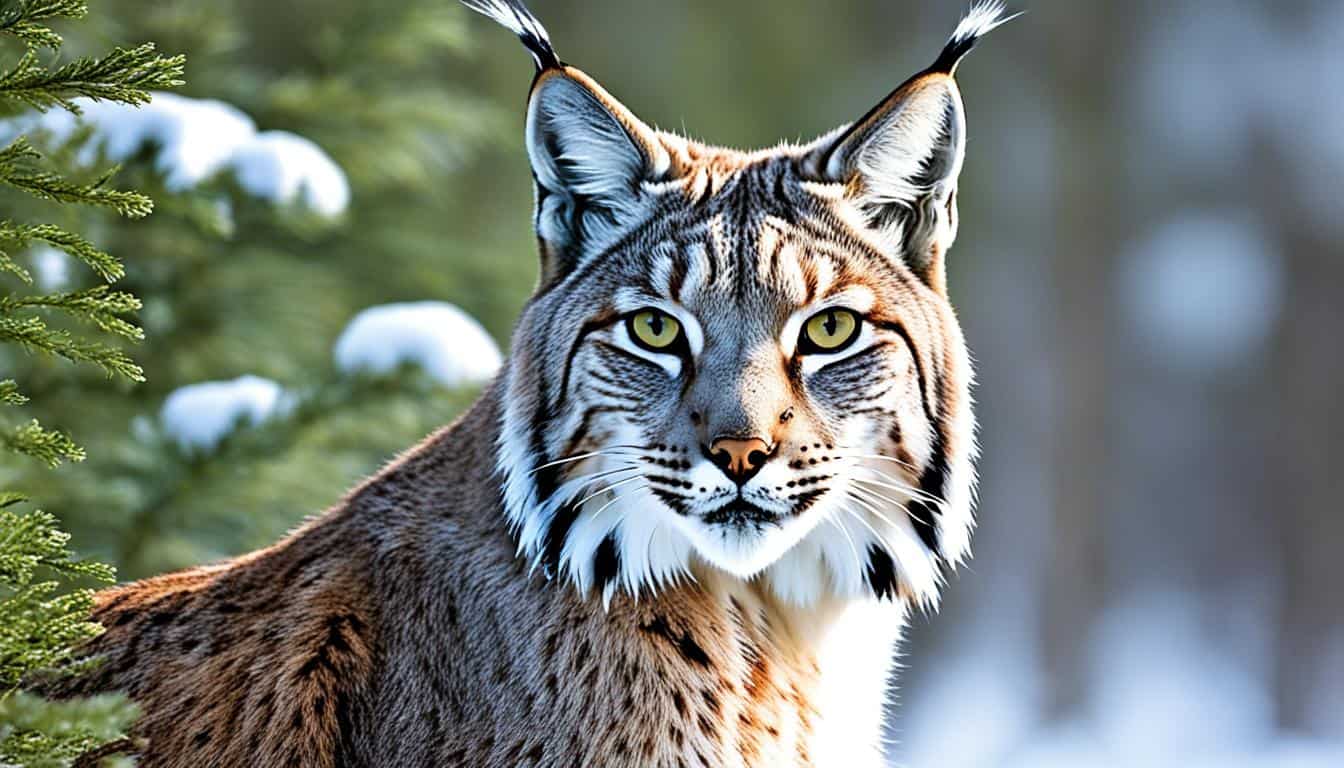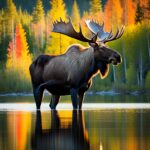Have you ever wondered how far the elusive American lynx roams across North America? The enigmatic journey of the Canada Lynx (Lynx canadensis) reaches from Canada down into parts of the U.S. It spills into Alaska as well.
This lynx’s range is closely connected to boreal and mixed deciduous forests. These environments are where they find their main food, the snowshoe hare. This makes their territory a place that is always changing and full of life.
Introduction to the American Lynx
The American Lynx, known widely as the Canada Lynx, is a captivating feline. It’s most at home in dense woods and cold places. This makes the American lynx habitat perfect for harsh climates.
Overview of American Lynx Species
This Lynx species has a special connection to the boreal forest. It lives across North America, choosing areas with snowshoe hares. The American lynx habitat covers parts of Canada and the northern US. It thrives where it’s cold and has lots of cover for hunting.
Physical Characteristics of the American Lynx
The American lynx has unique physical features that help it survive. It has distinctive black ear tufts, a short tail, and large footpads. These footpads are key, allowing the lynx to move easily on snow without sinking. Weights vary from 7.3 kg (16 lb) to 14 kg (31 lb). They’re between 76 cm (30 in) and 106 cm (42 in) long.
| Physical Trait | Description |
|---|---|
| Ear Tufts | Black tufts that enhance hearing capabilities |
| Tail | Short with a black tip, aiding in balance |
| Footpads | Broad to distribute weight on snow |
| Weight | Ranges from 7.3 kg (16 lb) to 14 kg (31 lb) |
| Body Length | Ranges from 76 cm (30 in) to 106 cm (42 in) |
Geographic Distribution of the American Lynx
The Canada Lynx, a type of American lynx, lives in forests across Alaska and Canada. It also goes into the northern United States. Knowing where they live helps us protect them and their homes.
Main Regions of Population
The American lynx loves to be in boreal forests. These forests are full of thick underbrush. This environment is ideal for hunting and living. They live in Alaska, parts of Canada like British Columbia and Quebec, and in some northern parts of the U.S. This includes places such as Maine, Montana, and Minnesota.
These areas are important because they have a lot of snowshoe hares. The lynx’s favorite food is the snowshoe hare. This is why the lynx is found where the hares are.
Historical Range
In the past, the American lynx was spread over a larger area. They could be found across many parts of Alaska, Canada, and the northern U.S. This was their old, vast home.
However, things have changed. Their range has gotten smaller over time. This is mainly because of human activity, breaking up their habitats, and climate change. Their homes aren’t the same as they used to be. Now, the lynx mainly stays in the boreal forests where it is still found.
| Region | Current Population Status |
|---|---|
| Alaska | Stable |
| Canada (British Columbia, Quebec) | Stable but localized |
| Northern United States (Maine, Montana, Minnesota) | Vulnerable |
| Other Northern U.S. States | Fragmented |
American Lynx Habitat Preferences
The American Lynx loves living in places that help them thrive and find food easily. They mainly live in two kinds of areas: boreal forests and mixed woodlands. These areas have different altitudes and landscapes which help them find food and stay safe.
Boreal Forests and Mixed Woodlands
Boreal forests are big and full of the things American Lynx need to live. With thick underbrush and lots of trees, they are perfect for hunting. The lynx’s favorite food, the snowshoe hare, is plentiful here.
American Lynx also make homes in mixed woodlands. These areas have a mix of evergreen and leaf-shedding trees. This mix creates more diverse food and homes for all sorts of animals. This balance helps the lynx and their prey to live together well.
Altitudes and Terrain
Lynxes can be found in different areas, including high up in the mountains. These high places have lots of trees, which are great for hunting. The trees also keep the lynx safe from bigger animals.
Lynxes are amazing at adapting to different environments. They can live in thick forests or in places with various kinds of trees. Their ability to live in many places shows how tough and adaptable they are in their natural homes.
Factors Affecting American Lynx Distribution
Prey availability plays a huge role in where American Lynx are found. Their numbers change based on snowshoe hare populations. If the hares decrease, the lynx’s living area gets smaller too.
Human actions also greatly affect where these lynx live. Building cities, cutting down forests, and breaking up natural spaces hurt their homes. This has led to fewer lynx in parts of southeastern Canada, because of human activity and climate changes.
Seasonal Variations in Lynx Movements
Lynx seasonal migration is fascinating. It shows how they change their movements based on the weather and food. This helps them survive in different environments.
Winter and Summer Ranges
American Lynxes travel further in winter. They do this because food, like the snowshoe hare, is harder to find. Their thick, furry paws help them move and hunt in the snow.
Migration Patterns
In summer, these Lynxes move to smaller areas. This is because food is more plentiful. They pick territories with enough food and shelter. These moves show how connected they are to their environment.
| Lynx Movement Patterns | Characteristics |
|---|---|
| Winter | Expanded ranges, migration in search of food, reliance on snowy terrains |
| Summer | Stable home ranges near forested areas, increased prey availability, territorial behavior |
Interaction of American Lynx with Other Species
American Lynx play a key role in their ecosystem. They are part of the predator-prey cycle, which is central to their habitat. Lynx mainly hunt smaller mammals, like the snowshoe hare, keeping their numbers in check.

Predators and Competitors
Lynx face off against bigger predators, such as mountain lions, wolves, and bears. These large predators compete for the same food, making life hard for the lynx. They also directly threaten the lynxes, making the system even more complex.
Role in the Ecosystem
Lynx are essential for balancing their ecosystem. By managing prey, they prevent overgrazing and keep the vegetation healthy. Their presence shows a healthy ecosystem where different predators live together. The lynx’s part demonstrates its critical place in the ecosystem, promoting biodiversity and stability.
Conservation Efforts and Challenges
Conserving the American Lynx involves protecting its habitat and setting up laws. Many programs work to keep the lynx safe and growing in the wild.
Protected Areas and Legislation
Secured spaces are very important in *lynx conservation*. Wildlife reserves keep the lynx away from people, helping them thrive. The Endangered Species Act protects them by law, stopping harmful actions and encouraging places for them to live. This law is key for lynx survival.
Conservation Programs
Special projects help save the Canada Lynx. The Lynx Recovery Plan focuses on watching over their numbers, managing their living areas, and educating the public. These steps help make the lynx stronger and safer, providing good *endangered species protection*. Teamwork between groups, government, and locals is critical for success.
“The preservation of the American Lynx is not solely about protecting a species; it’s about maintaining the health and balance of our ecosystems.” – U.S. Fish and Wildlife Service
Future Prospects for the American Lynx
The American Lynx’s future, especially the Canada Lynx, is tied to how well we manage wildlife and save their homes. We need to watch over lynx numbers and make sure their living spaces are kept or fixed. Conflicts with people and the changing climate are big problems. But, we’re working on smart ways to deal with them.
The way we use land is vital for the American Lynx’s survival. With towns and cities growing, we must protect wild spaces and make laws to keep them safe. It’s crucial to create paths for the lynx to travel and hunt without running into people.
Climate change is a big threat to the American Lynx too. Warmer temperatures and less snow mean fewer snowshoe hares for the lynx to eat. We’re working on rebuilding habitats and researching climate effects. A mix of saving homes and flexible wildlife care is key to keeping the lynx thriving in the USA and Canada.
FAQ
What is the range of the American lynx?
The American lynx lives in Canada, Alaska, and parts of the US. It, specifically the Canada Lynx, is tied to the snowshoe hare for food.
What are the key areas for the American Lynx population?
The American Lynx mainly lives in Canada and Alaska’s forests. They’re also seen in some parts of the northern United States.
How has the historic range of the American Lynx changed over time?
In the past, the lynx lived in Alaskan, Canadian, and some U.S. forest areas. But we’ve seen less of them in these places due to human activities. This includes habitat loss and other challenges.
What type of habitats do American Lynxes prefer?
American Lynxes like living in big forests with lots of hiding spots. They also go to different places for hunting, including high spots in the woods.
How do human activities impact the distribution of the American Lynx?
Human actions hurt where American Lynxes can live. For example, less snow due to warmer weather has made some areas less friendly for them.
Are there seasonal variations in the movements of the American Lynx?
American Lynxes move around a lot, depending on the season. They travel more in winter, looking for food. In summer, they find a spot they like and stay there.
What is the role of the American Lynx in the ecosystem?
The American Lynx helps keep the number of small mammals in check. They also deal with larger predators, like mountain lions and bears, which can be friends or foes.
What conservation efforts are in place for the American Lynx?
Many people are working to protect the American Lynx. This includes setting aside safe areas, rules to keep them safe, and special programs to help them thrive. In some spots, the Canada Lynx is listed as needing extra care to survive.
What are the future prospects for the American Lynx?
The American Lynx’s future is hopeful. But it depends on us using the land wisely and fighting climate change. We must keep a close watch, make homes for them, and solve problems where people and animals meet.







